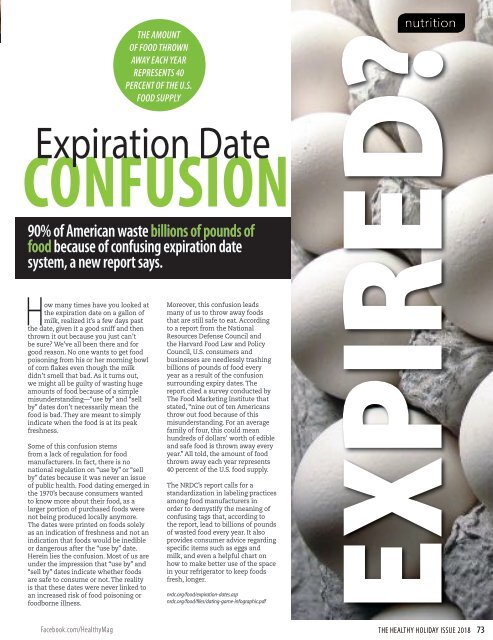You also want an ePaper? Increase the reach of your titles
YUMPU automatically turns print PDFs into web optimized ePapers that Google loves.
Expiration Date<br />
CONFUSION<br />
How many times have you looked at<br />
the expiration date on a gallon of<br />
milk, realized it’s a few days past<br />
the date, given it a good sniff and then<br />
thrown it out because you just can’t<br />
be sure? We’ve all been there and for<br />
good reason. No one wants to get food<br />
poisoning from his or her morning bowl<br />
of corn flakes even though the milk<br />
didn’t smell that bad. As it turns out,<br />
we might all be guilty of wasting huge<br />
amounts of food because of a simple<br />
misunderstanding—“use by” and “sell<br />
by” dates don’t necessarily mean the<br />
food is bad. They are meant to simply<br />
indicate when the food is at its peak<br />
freshness.<br />
Some of this confusion stems<br />
from a lack of regulation for food<br />
manufacturers. In fact, there is no<br />
national regulation on “use by” or “sell<br />
by” dates because it was never an issue<br />
of public health. Food dating emerged in<br />
the 1970’s because consumers wanted<br />
to know more about their food, as a<br />
larger portion of purchased foods were<br />
not being produced locally anymore.<br />
The dates were printed on foods solely<br />
as an indication of freshness and not an<br />
indication that foods would be inedible<br />
or dangerous after the “use by” date.<br />
Herein lies the confusion. Most of us are<br />
under the impression that “use by” and<br />
“sell by” dates indicate whether foods<br />
are safe to consume or not. The reality<br />
is that these dates were never linked to<br />
an increased risk of food poisoning or<br />
foodborne illness.<br />
Facebook.com/<strong>Healthy</strong>Mag<br />
THE AMOUNT<br />
OF FOOD THROWN<br />
AWAY EACH YEAR<br />
REPRESENTS 40<br />
PERCENT OF THE U.S.<br />
FOOD SUPPLY<br />
90% of American waste billions of pounds of<br />
food because of confusing expiration date<br />
system, a new report says.<br />
Moreover, this confusion leads<br />
many of us to throw away foods<br />
that are still safe to eat. According<br />
to a report from the National<br />
Resources Defense Council and<br />
the Harvard Food Law and Policy<br />
Council, U.S. consumers and<br />
businesses are needlessly trashing<br />
billions of pounds of food every<br />
year as a result of the confusion<br />
surrounding expiry dates. The<br />
report cited a survey conducted by<br />
The Food Marketing Institute that<br />
stated, “nine out of ten Americans<br />
throw out food because of this<br />
misunderstanding. For an average<br />
family of four, this could mean<br />
hundreds of dollars’ worth of edible<br />
and safe food is thrown away every<br />
year.” All told, the amount of food<br />
thrown away each year represents<br />
40 percent of the U.S. food supply.<br />
The NRDC’s report calls for a<br />
standardization in labeling practices<br />
among food manufacturers in<br />
order to demystify the meaning of<br />
confusing tags that, according to<br />
the report, lead to billions of pounds<br />
of wasted food every year. It also<br />
provides consumer advice regarding<br />
specific items such as eggs and<br />
milk, and even a helpful chart on<br />
how to make better use of the space<br />
in your refrigerator to keep foods<br />
fresh, longer.<br />
nrdc.org/food/expiration-dates.asp<br />
nrdc.org/food/files/dating-game-infographic.pdf<br />
EXPIRED?nutrition<br />
THE HEALTHY HOLIDAY ISSUE <strong>2018</strong> 73

















